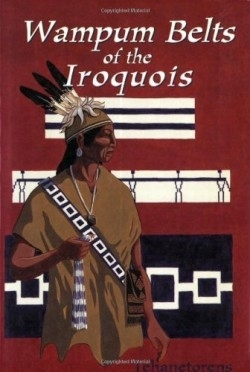Wampum Belts of the Iroquois
“Wampum should bring peace and bind peace and take the place of blood.” This is according to legend and tradition of how Hiawatha introduced wampum to the Iroquois at the founding of the League of Nations. Tehanetorens (Ray Fadden) has once again focused on the history of the Iroquois in presenting a new book on the significance of the wampum belt.
Wampum is an Algonquin Indian term describing the shell beads that were used in making the original wampum belts. Although immediately thought of as a form of currency, wampum was used by the tribes of the Iroquois
nation in religious and civic ceremony. Wampum belts had a key role in the everyday lives of each tribe in the League of Nations. Messengers carried wampum string to guarantee the message. Chiefs would not accept a message without it. Notice of civic or religious council was done with the wampum belt. A belt announced the death of a chief. The confirmation of treaties was done over a wampum belt as everyone knew no one would break a treaty agreed on over a wampum belt.
With the significance given the wampum belts and strings, the Onadonaga tribe was given the responsibility to be the Keeper of the Wampum. These people knew the history of each belt and recited it at the opening of each council meeting.
These facts and the other participating tribe’s contributions to the Iroquois Nation, along with the descriptions and photographs of the various wampum belts, are presented in this book. The manner in which the author has provided this information, with the descriptions of each belt and its individual meaning to the Iroquois, is a chronological record of the culture. One immediately notices the theme of peace and purity in all manner of living. In addition, it is evident from the constitution of the confederacy that other groups have drawn from this document the importance of peace and equality in their attempts to form other documents.
This book should enhance any school history class, as well as enlighten other readers to the importance of the wampum belts to the lives of the Iroquois and other Native Americans. It also lies to rest the notion that wampum belts were currency and decorations only. This in itself may motivate further class work or individual study on other history, crafts and social customs. The book would have been enhanced with directions on how to make a wampum belt.
From the description of how they were originally made before manufactured glass beads arrived to the role that they played in everyday life, a more accurate and detailed perspective of the wampum belt has been shared.
Reviewed by
Norvilla Bennett
Disclosure: This article is not an endorsement, but a review. The publisher of this book provided free copies of the book to have their book reviewed by a professional reviewer. No fee was paid by the publisher for this review. Foreword Reviews only recommends books that we love. Foreword Magazine, Inc. is disclosing this in accordance with the Federal Trade Commission’s 16 CFR, Part 255.

